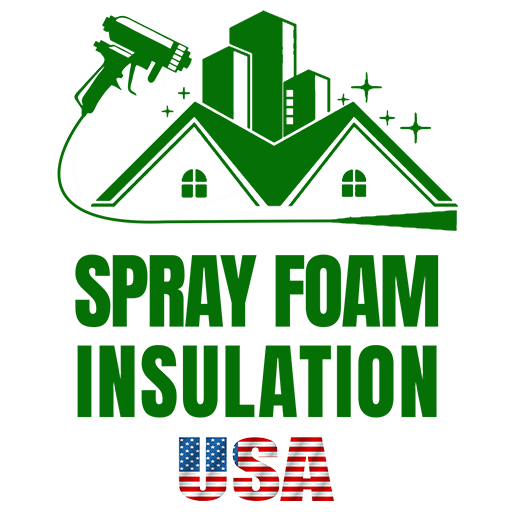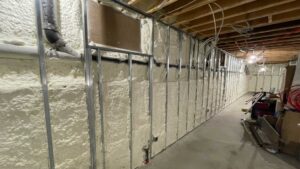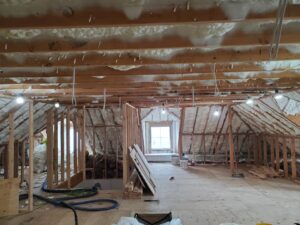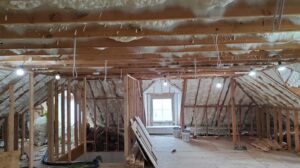The cost of insulating an attic can vary widely, but understanding these costs is crucial for homeowners and business owners looking to enhance energy efficiency and comfort. Briefly, homeowners might expect to spend between $830 to $7,000 on materials alone, with the price range depending on the type of insulation chosen, such as blown-in, batt, loose-fill, spray foam, or structural insulated panels (SIPs). Labor costs will add to this, influenced by the size of your attic and the complexity of the installation.
When considering attic insulation, it’s not just about the upfront costs; it’s about long-term savings on energy bills, creating a more comfortable living or working environment, and contributing to a healthier planet through energy-efficient, eco-friendly solutions. Whether you’re undertaking a new construction project or upgrading your existing attic insulation, knowing the potential costs involved is the first step toward making an informed decision that aligns with your energy-saving goals and budget.

In short, the cost of insulating an attic is an important consideration, but it’s equally important to weigh these costs against the benefits: significantly lower energy bills, improved comfort year-round, and an eco-friendly home improvement.
Why Insulate Your Attic?
Insulating your attic is like putting a warm hat on your house during the winter and a cool sunhat during the summer. It’s all about keeping your home comfortable, saving money on energy bills, and breathing easier. Let’s break down why it’s a smart move.
Energy Savings
Imagine every time you turn on the heat or the air conditioning, you’re not just warming or cooling your home, you’re also heating or cooling the neighborhood. Sounds wasteful, right? That’s exactly what happens when your attic is poorly insulated. Heat escapes during the winter, and cool air vanishes in the summer, making your HVAC system work overtime.
By insulating your attic, you can keep the desired temperature in your home more consistent. This means less work for your heating and cooling systems and more money in your pocket. In fact, some homeowners save between 30 and 50 percent on their energy bills after insulating their attics. That’s a huge saving!
Comfort Improvement
No one likes living in a house that feels like a freezer in the winter and an oven in the summer. Proper attic insulation helps maintain a comfortable temperature throughout your home, year-round.
This means no more wearing jackets indoors during the winter or sweating through the summer nights. Your living spaces will feel just right, making your home a more pleasant place to be, no matter the season.
Air Quality
Last but definitely not least, insulating your attic can improve the air quality inside your home. How? By reducing the amount of dust, pollen, and other outdoor allergens that can sneak in. Plus, a well-insulated attic helps prevent moisture buildup, which can lead to mold and mildew. This is especially important for families with allergies or respiratory issues.
Insulating your attic is more than just a home improvement project; it’s an investment in your home’s comfort, your family’s health, and your wallet. With benefits like these, it’s easy to see why so many homeowners choose to make the upgrade.
By focusing on energy savings, comfort improvement, and better air quality, you’re not just insulating your attic; you’re enhancing your quality of life. And remember, while the upfront cost might seem like a lot, the long-term savings and benefits are well worth it.
Types of Attic Insulation
When you’re looking to improve your home’s energy efficiency, comfort, and air quality, choosing the right type of attic insulation is crucial. Let’s break down the five main types of attic insulation: Blown-In, Batt, Spray Foam, Structural Insulated Panels (SIPs), and Reflective Insulation.
Blown-In Insulation
This type comes in three materials: Fiberglass, Cellulose, and Rock Wool. Blown-in insulation is a popular choice because it can easily fill in gaps and cover the attic floor evenly. It’s like pouring a blanket over your attic’s floor, wrapping it in a cozy layer that keeps your home warm in winter and cool in summer.
-
Fiberglass is made from fine glass fibers and is one of the most common materials used for blown-in insulation because of its fire resistance and ability to reduce noise.
-
Cellulose is eco-friendly, made from recycled paper products, and has a higher R-value per inch than fiberglass, making it a great option for those looking to maximize insulation effectiveness.
-
Rock Wool, also known as mineral wool, is made from basalt rock and recycled slag from the steel industry, offering excellent fire resistance and soundproofing qualities.
Batt Insulation
Batt insulation comes in pre-cut panels and is often made from Fiberglass, Cellulose, or Denim. It’s best suited for areas with standard joist and stud spacing that is free from obstructions.
-
Fiberglass Batts are easy to install and are a cost-effective option for DIYers. They provide good thermal resistance and sound insulation.
-
Cellulose Batts are denser than fiberglass, offering better soundproofing and thermal properties but may require professional installation due to the weight and handling of the material.
-
Denim Batts are made from recycled blue jeans, providing a unique, eco-friendly insulation option that is safe to touch and requires no special equipment to install.
Spray Foam Insulation
Spray foam comes in two types: Open-cell and Closed-cell. It’s sprayed into place, expanding to fill nooks and crannies, creating an airtight seal that significantly improves your home’s energy efficiency.
-
Open-cell Foam is lighter and more affordable but less effective at blocking moisture.
-
Closed-cell Foam is denser, offering higher R-values and acting as a vapor barrier, making it ideal for climates with extreme temperature variations.
Structural Insulated Panels (SIPs)
SIPs are made from a layer of foam insulation sandwiched between Plywood or Oriented Strand Board (OSB). They are pre-manufactured off-site and delivered ready to install, making them a quick and efficient insulation option for new construction or major renovations.
-
Plywood offers a traditional look and is often used in residential construction.
-
OSB is more cost-effective than plywood and is made from compressed layers of wood strands, making it strong and durable.
Reflective Insulation
Finally, reflective insulation, made from Aluminum foil or Aluminized polyester, works by reflecting radiant heat away from your home. It’s most effective in hot climates or in attics where direct sunlight increases indoor temperatures.
-
Aluminum foil is a highly reflective material that reduces heat transfer when placed in an airspace adjacent to a radiant heat source.
-
Aluminized polyester is similar to aluminum foil but is more durable and resistant to tearing, making it a good choice for areas that require more robust insulation solutions.
Each type of attic insulation has its benefits and ideal applications. Your choice will depend on factors such as your climate, the structure of your home, and your specific energy-saving goals. A well-insulated attic is key to reducing energy bills, increasing comfort, and improving the overall air quality in your home.
Cost Factors to Consider
When planning to insulate your attic, understanding the cost involved is crucial. The price can vary widely based on several factors, including the size of your attic, the type of insulation you choose, and whether you decide to hire professionals or do it yourself. Let’s break down these factors to give you a clearer picture of what you might expect to spend.
Average Cost by Attic Size
The size of your attic is one of the primary determinants of the cost of insulation. Here’s a quick guide to help you estimate:
- 500 sq. ft. might cost between $530 and $3,000.
- 750 sq. ft. could range from $795 to $4,500.
- For 1,000 sq. ft., expect to pay between $1,060 and $6,000.
- 1,200 sq. ft. attics might see prices from $1,375 to $7,000.
- And, a 1,500 sq. ft. space could cost between $1,590 and $9,000.
Labor Costs
Professional Installation
Hiring a professional can significantly affect the price. Professionals not only bring their expertise but also have access to higher quality materials and tools, which can drive up the cost. However, they can ensure the job is done quickly and efficiently, which might save you money in the long run by avoiding mistakes and ensuring the insulation is installed correctly.
DIY Considerations
For those considering the DIY route, the initial material cost might be lower, but don’t forget to factor in the cost of renting equipment and buying protective gear. The complexity of applying certain types of insulation, like spray foam, can also make DIY a challenging option. However, simpler types of insulation, such as batt or reflective insulation, might be more manageable for those with some home improvement experience.
Material Costs
The type of insulation you choose will also play a significant role in the overall cost:
- Reflective insulation is on the lower end, costing about $0.50 to $1.50 per square foot.
- Blown-in insulation prices range from $0.83 to $3.60 per square foot.
- Structural insulated panels (SIPs) are on the higher end, ranging from $4 to $7 a square foot.
Choosing the right type of insulation involves balancing your budget with your climate needs and energy-saving goals.
Insulation Type
The type of insulation not only affects the material cost but also the labor involved. For instance, blown-in insulation might require special equipment and expertise to install, potentially increasing labor costs. In contrast, batt insulation can be more straightforward and thus cheaper in terms of labor.
In summary, the cost of insulating an attic is influenced by a variety of factors, including the size of your attic, the type of insulation you opt for, and whether you hire professionals or decide to take on the project yourself. Carefully considering each of these factors will help you make an informed decision that meets your needs and fits your budget. As we move into the next section, keep these cost factors in mind as they play a crucial role in planning your attic insulation project.
Additional Considerations
When thinking about the cost of insulating your attic, there are a few more things you need to consider. These are just as important as choosing the right type of insulation. Let’s break them down.
Air Sealing
Before you even start with insulation, air sealing is a must. Why? Because it stops warm or cool air from escaping your home. This can save you a lot of money on energy bills. The cost of air sealing can range from $250 to $750. While it might seem like a big expense upfront, it’s worth it in the long run. Air sealing your attic keeps your home more comfortable and saves on heating and cooling costs.
Insulation Replacement and Removal
Sometimes, you need to take out the old to bring in the new. If your attic has old or damaged insulation, it’s got to go before you can install new insulation. This is important because old insulation might not be effective anymore. The cost for this can vary widely, depending on how much insulation there is to remove and what condition it’s in. Generally, you’re looking at a range from $1 to $2 per square foot for removal.
Cleaning and Preparation
Before installing new insulation, your attic might need some cleaning and prep work. This could include fixing any leaks or structural issues. The cleaner and more prepared your attic is, the better your new insulation will perform. While some homeowners might tackle this themselves, professional cleaning can add to the overall cost.
Whole-home Insulation
While we’re focusing on the attic, it’s good to think about your whole home. If your attic is well-insulated but the rest of your home isn’t, you’re still going to face energy loss. Consider having a professional assess your entire home’s insulation needs. This might increase your upfront costs but can lead to bigger savings on energy bills.
In summary, don’t just think about the insulation material and labor costs. Remember to factor in air sealing, the potential need for insulation removal, and any cleaning or repairs your attic might need. Also, consider the insulation needs of your entire home for the best energy efficiency. By taking these additional steps, you’re ensuring a more comfortable, energy-efficient home for years to come.
FAQs about Attic Insulation
What is R-Value?
R-Value measures how well insulation can resist heat flow. The higher the R-value, the better the insulation’s effectiveness. It’s like a coat’s thickness in winter; the thicker the coat, the warmer you stay. Different parts of your home need different R-values. For example, attics in cold climates might need R-49 to R-60, while in warmer areas, R-30 to R-38 could be enough. Always check the Department of Energy’s recommendations for your specific area.
Can I DIY Attic Insulation?
Yes and no. It depends on the insulation type and your skill level. Installing batt insulation might be doable if you’re handy and have basic home improvement skills. But, for more complex types like spray foam, it’s best to hire professionals. Spray foam, in particular, requires precise application and special equipment. Plus, dealing with electrical wiring and ensuring proper ventilation makes professional installation a safer choice. Incorrect installation can lead to problems like poor insulation, moisture issues, and even fire hazards.
How Long Does Insulation Installation Take?
The time it takes to insulate an attic varies. It depends on the attic size, insulation type, and any prep work needed. On average, a professional team can insulate a standard attic in about 6 to 8 hours. But, if your attic needs air sealing or old insulation removal, it could take longer. Spray foam insulation might also extend the timeline due to its complexity. Planning for a day or two of work is wise, especially for larger attics or more complicated projects.
In summary, understanding the R-value helps you choose the right insulation for your home. While DIY attic insulation can be tempting, assessing your skills and the project’s demands is crucial. And, knowing how long the process takes helps set realistic expectations. Next, we’ll dive into Spray Foam Insulation USA’s solutions and how they can benefit your home’s energy efficiency and comfort.
Conclusion
At Spray Foam Insulation USA, we understand the importance of a well-insulated attic. Not only does it contribute to significant energy savings, but it also enhances the comfort of your home, making it a cozy haven regardless of the season. Our commitment to providing top-notch attic insulation solutions is rooted in our understanding of how crucial this aspect of home improvement is for homeowners.
Why Choose Us?
-
Expertise: Our team is equipped with the knowledge and skills to ensure that your attic is insulated using the best materials and techniques. We specialize in spray foam insulation, a superior choice for achieving an airtight seal and high R-value, ensuring that your home remains energy-efficient and comfortable year-round.
-
Tailored Solutions: We recognize that every home is unique. That’s why we offer personalized insulation solutions designed to meet the specific needs of your attic. Whether you’re dealing with an unusual layout or specific climate challenges, we’ve got you covered.
-
Sustainability: By choosing spray foam insulation, you’re not just improving your home’s energy efficiency; you’re also making a choice that benefits the planet. Spray foam insulation is known for its ability to reduce energy consumption, lowering your carbon footprint.
-
Professional Installation: The success of spray foam insulation lies in its correct application. Our professionals are trained and experienced in installing spray foam insulation, ensuring it’s done right the first time. This eliminates potential issues such as mold or inadequate ventilation, which can arise from improper installation.
Let’s Wrap It Up
The cost of insulating your attic is an investment in your home’s future. Not only does it lead to lower energy bills, but it also enhances the overall comfort and value of your home. With Spray Foam Insulation USA, you can rest assured that your attic insulation project is in good hands. Our focus on quality, sustainability, and customized solutions makes us the ideal partner for your insulation needs.
Ready to improve your home’s energy efficiency and comfort? Contact us today for a free estimate and let’s make your home the best it can be with top-tier attic insulation.
In choosing Spray Foam Insulation USA, you’re opting for a partner who values your comfort and energy efficiency as much as you do. We’re here to guide you every step of the way, ensuring that your attic insulation project is a success, enhancing your home’s efficiency and comfort for years to come.





